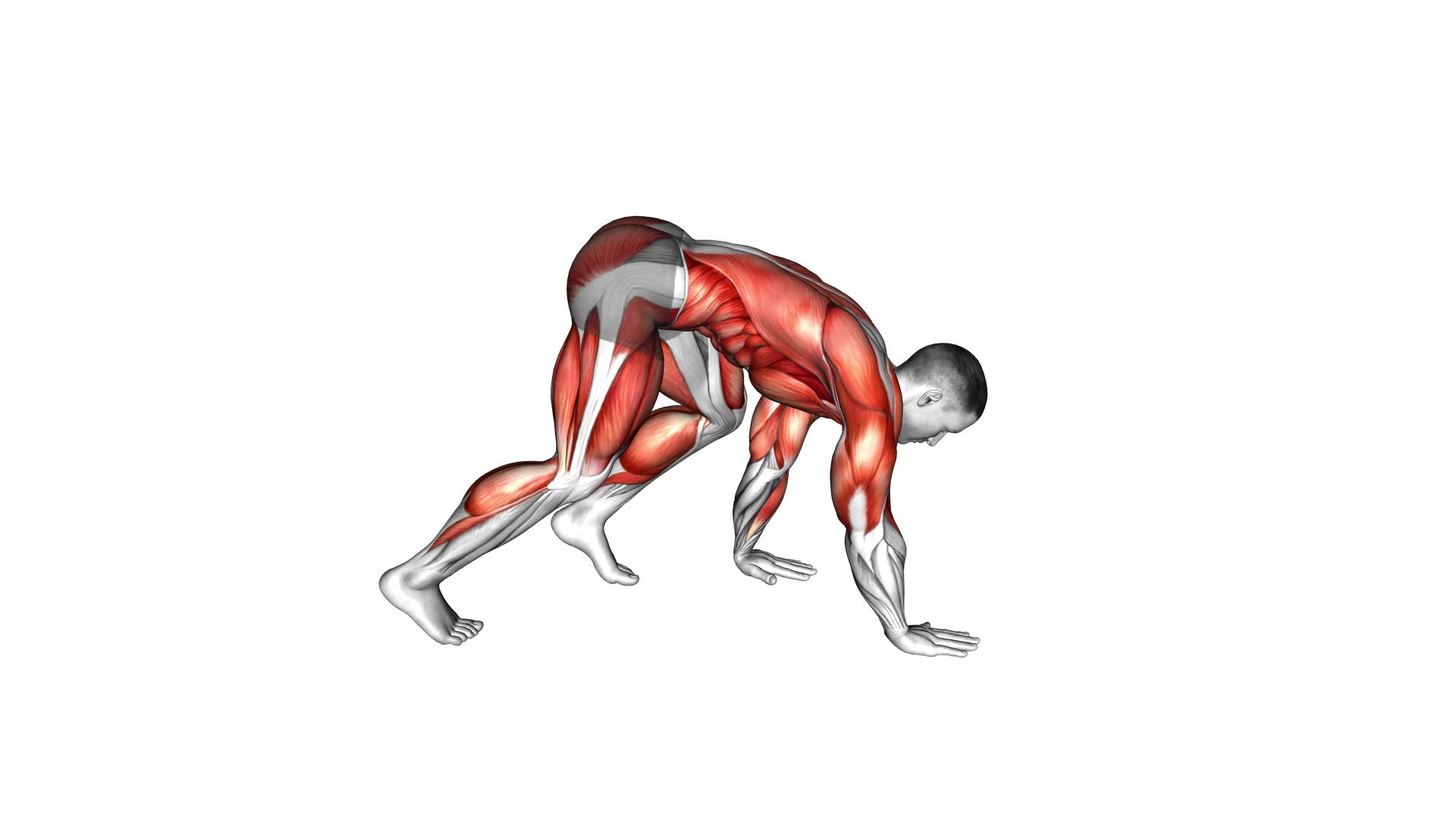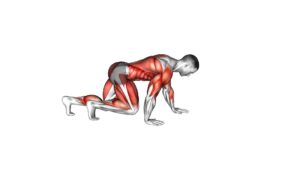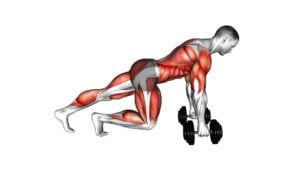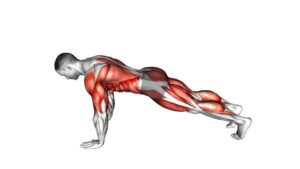Bear Crawl – Video Exercise Guide & Tips

Looking to get a full-body workout that's challenging and effective? Look no further than the bear crawl!
Watch This Exercise Video
In this video exercise guide, we'll show you the proper form and technique for this dynamic exercise. With variations to suit all fitness levels, the bear crawl targets multiple muscle groups and can help you improve strength, endurance, and mobility.
Maximize your results and avoid common mistakes with our expert tips.
Get ready to unleash your inner bear and transform your fitness routine!
Key Takeaways
- Bear crawl workouts have numerous benefits, including improving strength, endurance, mobility, core strength, stability, and overall fitness.
- Proper form and technique are crucial for maximizing the effectiveness of bear crawl exercises and preventing injuries.
- There are various variations of bear crawl exercises that target different muscle groups and add an extra challenge to the workout.
- To maximize results, it is important to adjust the intensity levels, incorporate bear crawl into circuit training routines, maintain proper form, and gradually increase the duration and intensity of the exercise.
Benefits of Bear Crawl
The bear crawl exercise offers numerous benefits for your entire body. One of the key advantages of bear crawl is that it can be modified to suit your fitness level and goals. Whether you're a beginner or an advanced athlete, there are various ways to modify the bear crawl exercise. For instance, you can increase the intensity by adding resistance bands or weight plates to challenge your muscles even more. On the other hand, if you're just starting out or have limited mobility, you can perform the bear crawl on your knees instead of on your feet.
Another important benefit of bear crawl is that it helps improve core strength. As you move forward and backward in the bear crawl position, your core muscles, including your abdominals, obliques, and lower back, are engaged to stabilize your body. This not only strengthens your core, but also improves your overall stability and balance. A strong core is essential for performing daily activities and for other exercises, as it provides a solid foundation for movement.
Now that you understand the modifications and the importance of core strength in the bear crawl exercise, let's move on to the next section where we'll discuss the proper form and technique.
Proper Form and Technique
To ensure proper form and technique during the bear crawl exercise, it's crucial that you maintain a strong and stable core throughout the movement. This will help you avoid common errors and maintain proper alignment.
One common error in the bear crawl is allowing your lower back to sag or arch. This puts unnecessary strain on your spine and decreases the effectiveness of the exercise. To maintain proper alignment, engage your core by drawing your belly button towards your spine. This will help you keep your back straight and prevent any excessive arching or sagging.
Another common error is lifting your hips too high or too low. When your hips are too high, you put excessive strain on your shoulders and wrists. Conversely, when your hips are too low, you lose the benefits of the exercise and decrease the engagement of your abdominal muscles. Aim to keep your hips in line with your shoulders and knees throughout the movement.
Variations of Bear Crawl
To add variety and challenge to your bear crawl exercise, you can explore different variations that target specific muscle groups and enhance overall strength and stability. Bear crawl modifications can help you intensify your workout and engage different areas of your body.
One advanced bear crawl variation is the bear crawl with a push-up. Start in the bear crawl position and perform a push-up before moving forward. This variation adds an upper body strengthening element to the exercise, targeting your chest, shoulders, and triceps.
Another modification is the bear crawl with a knee tuck. While in the bear crawl position, bring your knees towards your chest, engaging your core muscles and adding an extra challenge for your abdominal muscles.
For an advanced bear crawl variation that targets your glutes and hamstrings, try the bear crawl with a leg lift. As you crawl forward, lift one leg off the ground and extend it straight behind you. Alternate legs as you move, focusing on squeezing your glutes and engaging your hamstrings.
Incorporating these bear crawl modifications and advanced variations into your routine can help you diversify your workout, target specific muscle groups, and enhance overall strength and stability. Remember to maintain proper form and technique throughout each variation to maximize the benefits and minimize the risk of injury.
Muscle Groups Targeted
Engage multiple muscle groups with the bear crawl exercise. The bear crawl is a versatile exercise that targets several muscle groups simultaneously, making it an effective full-body workout. One of the primary benefits of the bear crawl is its ability to strengthen the core muscles. As you crawl on all fours, your abs, obliques, and lower back muscles work together to stabilize and support your spine. This not only helps improve your posture but also enhances overall core strength.
In addition to targeting the core, the bear crawl also improves stability and coordination. When you perform this exercise, you engage your shoulders, arms, and chest muscles to maintain balance and control. This helps to strengthen these muscles and improve stability in the upper body.
Furthermore, the bear crawl requires coordination between your arms and legs as you move opposite limbs together. This coordination challenge enhances motor skills and proprioception.
Tips for Maximizing Results
Get the most out of your bear crawl exercise with these simple tips:
- Adjust the intensity levels for different fitness levels:
Whether you're a beginner or an advanced athlete, the bear crawl can be modified to suit your fitness level. If you're a beginner, start by performing the bear crawl on your hands and knees. As you progress, you can increase the intensity by crawling on your hands and toes, or even adding resistance by wearing a weighted vest.
- Incorporate bear crawl into circuit training routines:
Circuit training is a great way to maximize your workout and burn more calories. Include the bear crawl in your circuit by performing it for a set amount of time or distance, followed by other exercises. This will challenge your muscles and cardiovascular system, leading to greater overall fitness gains.
- Maintain proper form:
To get the most out of the bear crawl, it's important to maintain proper form. Keep your core engaged, your back flat, and your shoulders stable. This will ensure that you're targeting the intended muscle groups and minimizing the risk of injury.
- Increase the challenge with variations:
Once you've mastered the basic bear crawl, try incorporating variations to increase the challenge. For example, you can crawl backwards, sideways, or even crawl up and down stairs. These variations will engage different muscles and add variety to your workout routine.
- Gradually increase the duration and intensity:
To maximize your results, gradually increase the duration and intensity of your bear crawl workouts. Start with shorter distances or time intervals, and gradually work your way up. This will help you build strength, endurance, and improve overall fitness.
Common Mistakes to Avoid
Avoid these common mistakes to ensure you get the most out of your bear crawl exercise and avoid injury. Proper alignment is crucial when performing the bear crawl, so be mindful of your body positioning throughout the movement.
One common mistake is letting your hips sag or your back round. This can put excessive strain on your lower back and reduce the effectiveness of the exercise. To avoid this, engage your core muscles and keep your back flat. Imagine a straight line from your head to your tailbone.
Another mistake to avoid is rushing through the movement. The bear crawl is a slow and controlled exercise that requires coordination and stability. Take your time and focus on maintaining proper form. This will help you engage the right muscles and prevent unnecessary strain.
It's also important to avoid locking out your elbows or hyperextending your knees. This can lead to joint pain and potential injury. Keep a slight bend in your elbows and knees to maintain stability and protect your joints.
Lastly, be cautious of overextending your wrists. The bear crawl puts pressure on your wrists, so it's essential to maintain proper wrist alignment. Keep your wrists neutral and distribute the weight evenly to avoid discomfort and potential injury.
Frequently Asked Questions
How Many Calories Can Be Burned During a Bear Crawl Workout?
During a bear crawl workout, you can burn a significant amount of calories. This exercise engages multiple muscle groups, including your core, shoulders, and legs, which helps increase your heart rate and calorie burn.
Bear crawl is a full-body exercise that offers many benefits, such as improved strength, endurance, and coordination. Additionally, it can be a great option for a cardio workout, as it involves constant movement and requires a lot of energy.
Can Bear Crawl Help Improve Overall Agility and Coordination?
Bear crawl is a fantastic exercise for improving overall agility and coordination. By performing the bear crawl technique, you engage multiple muscle groups and challenge your body to move in a coordinated manner. This exercise requires you to maintain a stable core while moving your limbs, which helps enhance your balance and body control.
Additionally, the bear crawl benefits include increased joint mobility, strengthened muscles, and improved cardiovascular endurance. Incorporating bear crawl into your workout routine can help take your agility and coordination to the next level.
Is It Safe to Do Bear Crawl Exercises if You Have Wrist or Shoulder Injuries?
If you have wrist or shoulder injuries, it's important to consider modifications and alternatives for bear crawl exercises. These modifications can help you continue to work on your agility and coordination without aggravating your injuries.
Can Bear Crawl Be Included in a High-Intensity Interval Training (Hiit) Workout?
Yes, bear crawl can definitely be included in a high-intensity interval training (HIIT) workout. It's a challenging exercise that targets multiple muscle groups and increases cardiovascular endurance.
Bear crawl variations, such as adding lateral movements or incorporating push-ups, can further intensify the workout.
The benefits of bear crawl in strength training include improved core stability, increased upper body and lower body strength, and enhanced overall body coordination.
Are There Any Modifications or Adaptations for Individuals With Limited Mobility or Physical Disabilities?
For individuals with limited mobility or physical disabilities, there are adaptive modifications and equipment options available for the bear crawl exercise. These modifications can help make the exercise more accessible and suitable for different needs.
By using assistive devices, such as resistance bands or stability balls, individuals can modify the bear crawl to suit their abilities.
Additionally, a certified fitness professional or physical therapist can provide personalized adaptations based on specific limitations or disabilities.
Conclusion
In conclusion, incorporating bear crawls into your exercise routine can provide numerous benefits. These include improved core strength, increased mobility, and enhanced overall body stability. By maintaining proper form and technique, you can effectively target a variety of muscle groups. These include the shoulders, arms, and core.
To maximize results, consider trying different variations of the bear crawl. Additionally, it is important to be mindful of common mistakes to avoid. With consistent practice, you can achieve optimal results and enhance your fitness journey.

Author
Years ago, the spark of my life’s passion ignited in my mind the moment I stepped into the local gym for the first time. The inaugural bead of perspiration, the initial endeavor, the very first surge of endorphins, and a sense of pride that washed over me post-workout marked the beginning of my deep-seated interest in strength sports, fitness, and sports nutrition. This very curiosity blossomed rapidly into a profound fascination, propelling me to earn a Master’s degree in Physical Education from the Academy of Physical Education in Krakow, followed by a Sports Manager diploma from the Jagiellonian University. My journey of growth led me to gain more specialized qualifications, such as being a certified personal trainer with a focus on sports dietetics, a lifeguard, and an instructor for wellness and corrective gymnastics. Theoretical knowledge paired seamlessly with practical experience, reinforcing my belief that the transformation of individuals under my guidance was also a reflection of my personal growth. This belief holds true even today. Each day, I strive to push the boundaries and explore new realms. These realms gently elevate me to greater heights. The unique combination of passion for my field and the continuous quest for growth fuels my drive to break new ground.







